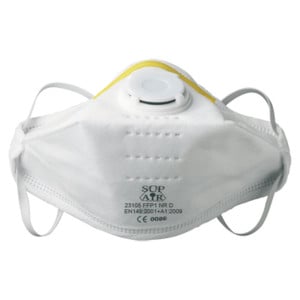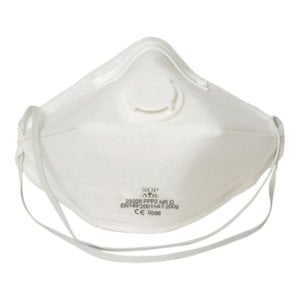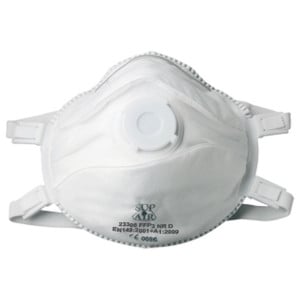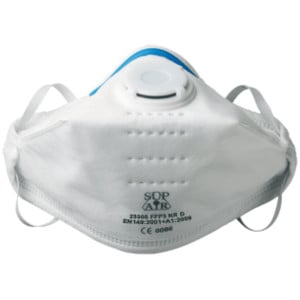Sup Air respiratory protection
-

Disposable folding breathing mask with Sup Air FFP1 D SL valve (box of 20 masks)
As low as €20.07 €20.07 -

Sup Air foldable breathing mask with FFP2D SL valve (box of 20)
As low as €20.08 €20.08 -
-
Promo -10

Shell breathing mask with Sup Air FFP3 NR SL valve (set of 5 masks)
As low as €10.54 €10.54 Was price €11.71 -
The PPE, whatever they are, are intended to preserve the safety and health of employees. This also applies to masks. Certain professions and activities require them to be worn, whether occasionally or exceptionally. The SUP AIR brand offers here single-use or limited-use half masks suitable for several areas of activity.
The principle of SUP AIR respiratory protection
The purpose of a mask, whether it is a half mask or a full mask, is to provide the best possible air quality to its wearer. This may be to protect the employee from poor air quality due to a too concentrated presence of dust, gas, smoke, vapour, etc. It can also mean providing the necessary amount of breathable air when an area is low in oxygen. Both cases can also occur at the same time.
However, it should be noted that measures to improve the conditions encountered by an employee must first be respected. It is only once these measures prove ineffective or will not have the necessary impact to guarantee its safety that wearing a mask will enter is recommended.
Features of SUP AIR respiratory protection
SUP AIR respiratory protection is designed with carefully selected resistant materials to keep users safe. In this section, we will focus on the characteristics of the SUP AIR half masks.
These types of personal protective equipment cover the nose, mouth and chin. With the preformed foam nose seal, these half masks adapt perfectly to the shape of the face. Thus, they offer better comfort to the user. In addition, the soft polypropylene inner layer ensures a silky feel on the face and reduces fogging. SUP AIR half masks are also equipped with developed filters preventing any toxic particles from entering, with an exhalation valve and adjustable straps.
Steps to follow to choose the right SUP AIR respiratory protection
Depending on the conditions encountered, respiratory protection differs between them, each mask must therefore be chosen with great care.
Several actions must be taken before opting for one mask or another, in order to have the right protection according to the risk involved. 3 steps must be followed scrupulously for this:
- The nature of the pollutant must be identified. At the same time, it will also be necessary to ensure that you know the oxygen level in the defined work area.
- The average exposure values or VME, the exposure limit values or VLE and also the concentration of contaminants or CAS should also be taken into account.
- Finally, the practicality of wearing the mask must be taken into account: its lightness, ease of use and comfort of use are all points to be seen.
Once these 3 steps have been completed, the choice can be made. But its conformity before actual use will still have to be ensured.
Design standards for SUP AIR respiratory protection
Regulation 2016/425 sets the standards for respiratory masks. Their number goes up to 50, varying according to the conditions encountered to offer maximum protection to its wearer. In the case of SUP AIR half masks in this section, 3 standards govern their design:
The FFP1 standard
Masks in this category are intended to protect against aerosols and non-toxic dust. They precisely protect against solid aerosols and non-toxic liquids. It can be, for example, cement, coal, cotton, flour or even soft woods. The textile industries, metallurgy, crafts and carpentry are the sectors that use this type of brand a lot.
It should be noted that these respiratory protections are not for single use, on the other hand they have a very limited use. The masks of this standard can no longer be used beyond 4 sessions of 8 hours.
The FFP2 standard
This standard governs the design of masks that protect against aerosols and low-toxic dust. More specifically, FFP2 protects the worker against solid aerosols, FFP1 liquids and those that are weakly toxic. Examples include wood, bacteria, fungi, tuberculosis bacillus, quartz, copper, etc. They are often found in the hospital sector, carpentry, the textile industry, for underground public works, among others.
Its use is also very limited, since wearing the same mask cannot be authorized for more than 10 8-hour sessions.
The FFP3 standard
FFP3 standard respiratory protection protects against solid aerosols, FFP1, FFP2 dust and toxic dust. It can be chromium, manganese, asbestos, metal fumes or even viruses. Hospitals and laboratories particularly consume this type of mask as well as the textile industry, crafts, metallurgy etc.
The use of this mask lasts longer since it can go up to 50 sessions of 8 hours without losing its effectiveness.

